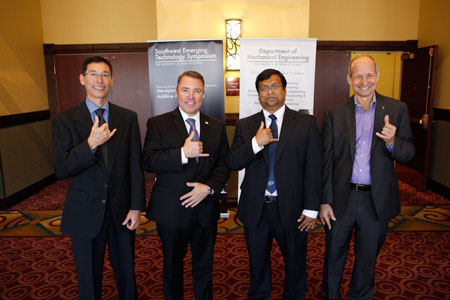Originally published May 9, 2016
By Lisa Y. Garibay
UTEP Communications
Students from The University of Texas at El Paso’s departments of mechanical engineering; electrical and computer engineering; physics; chemistry; computational science; and industrial, manufacturing and systems engineering had the chance to strut their very capable stuff alongside experts from the likes of NASA and Lockheed Martin at the sixth annual Southwest Emerging Technology Symposium (SETS) in April 2016.
The event, formerly known as the Southwest Energy Science and Engineering Symposium, has regularly provided career-building access for students from both UTEP and across the country in a professional conference setting, connecting these students with researchers, scholars and industry professionals for collaboration and recruitment.

Organizer Ahsan Choudhuri, Ph.D., professor and chair of UTEP’s mechanical engineering department, said the symposium’s name change was more reflective of the ever-broadening field, including its variety of research focuses and available career paths.
“SETS is a platform showcasing UTEP’s growing national preeminence in aerospace, additive manufacturing (also known as 3-D printing) and energy engineering research while expanding economic development for the region,” he said.
By providing a place for undergraduate through doctoral students to deliver paper and poster presentations to established professionals, SETS creates opportunities for students to increase their poise and experience giving presentations, which raises these emerging scholars above their peers.
Doctoral student Shaimum Shahriar was eager to meet new people both within and outside of his arena at the symposium.
“It’s a very good opportunity to learn more from other people and experts,” Shahriar said. He presented his work on inorganic-organic hybrid solar cells, harvesting sustainable energy using materials no one has ever tried before. “I’m working on stability and improving performance. Once it’s more stable, it’ll change a lot of things within the solar industry,” he said.
Faculty representatives from a variety of disciplines also attended, demonstrating the interdisciplinary nature of the symposium’s subject matter.
Assistant Professor of Electrical and Computer Engineering Deidra Hodges, Ph.D., was thrilled with the chance for her students to put their research on display for potential employers like Shell, noting that a representative from the Massachusetts Institute of Technology invited UTEP Ph.D. candidates to present at a conference there this summer.
“When we connect with others, who knows what we’ll come up with,” Hodges said. “It’s all about the interactions.”
Along with its new name, an addition to SETS this year was a free interactive informational session for local high school students to learn more about the career opportunities offered within the engineering sector. Ryan Wicker, Ph.D., who directs UTEP’s W.M. Keck Center for 3D Innovation, moderated the discussion.
“Engineering opens doors for all sorts of things for you,” he told attendees at the special breakout presentation, stressing that every student who graduates from UTEP with a degree in engineering gets a job. “We spend a lot of time with each one of them to make that happen,” he said.
“We think that 3-D printing is the future of the world,” Wicker added as he passed out examples of what the technology can accomplish for the students, their parents and teachers to examine. For many, it was the first time they had heard about the Keck Center, which is one of the best university facilities for additive manufacturing, the more formal designation for 3-D printing, in the world.
Two of the symposium’s keynote speakers – John Applewhite, chief of the propulsion branch at NASA Johnson Space Center, and Nick Gonzales, director of systems engineering at Lockheed Martin Space Systems – offered candid recollections of how they got where they are today and encouraged students to ask anything they wanted.
Applewhite and Gonzales also offered business cards and welcomed email queries from those in attendance, opening up a direct line of communication with the high school students.
“It’s really going to be the younger generation that gets us there,” Applewhite said about the mission to Mars and further space exploration overall. He discussed how he was a first-generation American and college graduate, which no doubt resonated with many attendees.
Gonzales emphasized how engineering “touches absolutely everything,” pointing out that the lighting, air conditioning and structure of the room out to cars on the road and even medicines and health care all have engineering as their foundation.
While the UTEP students – who rushed around delivering or attending presentations throughout the entire day – certainly got something out of the symposium, the professionals in attendance also benefited.
“Networking is ultimately important,” Applewhite said. “In constrained environments, we really have to be able to work together better than we have in the past, both internally and externally, and leverage the capabilities that are out there … It’s settings like this one that allow us to bring folks together, share ideas, understand where the common interests are and then start getting things going. That’s absolutely critical.”
“The excitement that I feel when I come here rubs off on me and I can bring that back to my workforce,” Gonzales said. “I really am interested in hearing what the students think and how they think and see engineering and try to communicate the mission that we perform and use that to create excitement. And I’m really enjoying the interaction and the ability to share the realities of what goes on day to day.”